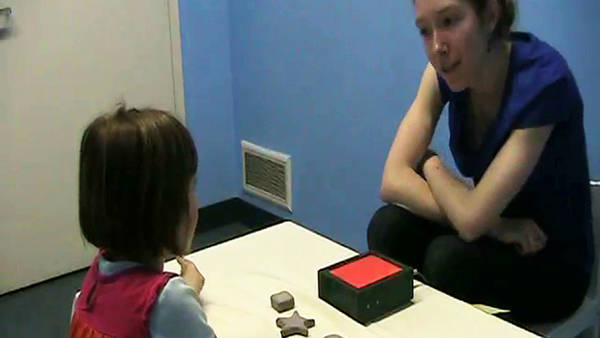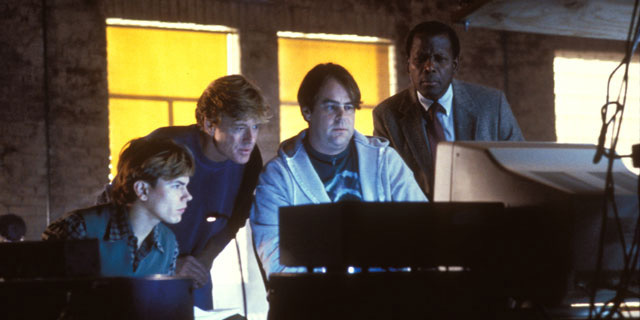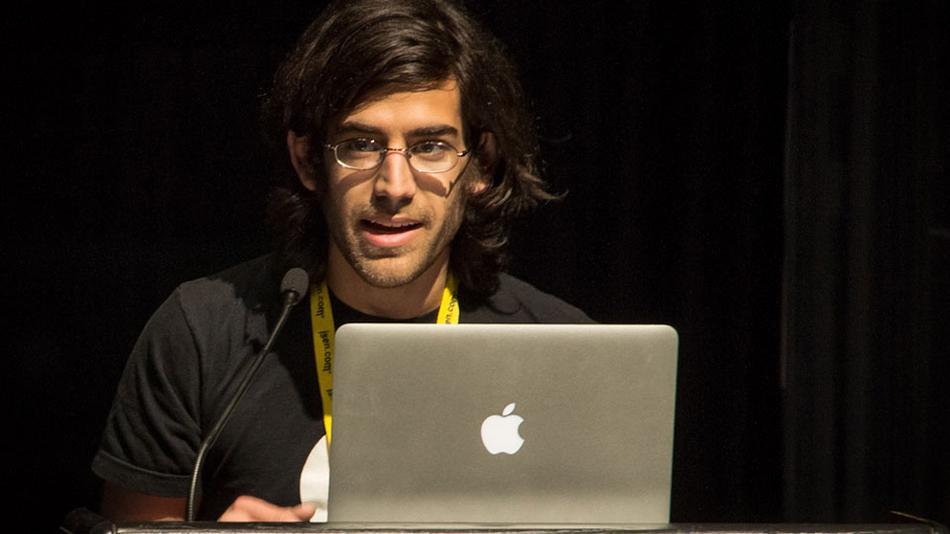Children and Hackers [Santa Fe Institute and Center for Contemporary Arts, Science on Screen]
Children and Hackers:
remarks before a showing of Sneakers
Simon DeDeo
simon[at]santafe.edu
Informal Public Lecture for Science on Screen, Wednesday 8 May 2013, 7 pm
[back to popular articles / back to main page]
The Institute’s next Public Lecture is tomorrow evening; it’s by Alison Gopnik, who just finished blowing our minds in a more technical talk up at the Institute’s campus on Wednesday. This is going to be a fun evening, but the real fun, the real thing, is tomorrow. And it’s free! Santa Fe Institute. Remember us. All joking aside, it will be great [1].
Alison started her life as a philosopher, but ended up doing foundational work in childhood development: somewhere in the first three years, a human baby that’s been tracking the standard primate curve for cognitive ability rockets forward to the wise animals that we understand ourselves to be [2]. So what is happening at this magic point, what does the birth of reason look like?
Alison talked about what you see when you watch what children do. This sounds obvious: if you want to know how children develop, you should probably take a look for yourself. And that’s what she did: to be explicit, she looked to what children actually did, rather than what they were explaining they did.

She showed us, among other things, an extremely moving video clip of a young boy solving a puzzle, moving colored blocks around, trying to determine the properties of their combination that had been hidden inside them by means of some electronic trickery.
At the highest level, watching this film is watching a child move from the discovery of accidental correlations to the determination of cause and effect. This is a variety of human experience, an instantly recognizable one; to watch a child who is just waking up in the physical world do this is incredible. If you do it for a living, as a scientist, the feeling is almost overwhelming.
It’s also amusing, because correlation is easy, causation is hard, and science is about causation. Causation is hard, it’s really hard—my collaborators and I have been trying to teach a computer to do cause and effect for four years, and now I’m watching a kid do this, I mean, it’s perfect. Why is a three year old better than a thirty-three year old at this?
Alison is not just a great researcher, she also had a really nice rhetorical structure. So if children are scientists, what am I? Well, OK, so if children are scientists, then scientists are just children who haven’t grown up.

Which brings me to the movie we’re seeing tonight. Sneakers is a film about a bunch of adults who don’t want to grow up. There’s an enormous power in that, something that lies between the choice not to grow up, and the ability not to. Scientists know this implicitly, and I think it’s one of the reasons why the film is so popular for them, and why so many of us remember it decades later.
None of the main characters in Sneakers has a Ph.D., but when you see this film, this theme of play is extremely familiar. The characters in this film are scientists. They’re just very naughty scientists. They’re hackers! Since we’re talking about degrees, perhaps the best description of a hacker is a scientist who dropped out of high school.
Let me put a twist on this story, one last twist before we show the film. Because before I heard Alison’s talk yesterday I had a very different story I wanted to tell you. A few weeks ago I was in Cambridge, Massachusetts. I had arrived the day after the Boston bombings. I was on my way to one of the great incubators, one of the great childhood-makers, I guess you would say, MIT.
I was on the subway, the T, at the Kendall-MIT stop, and there was a bomb scare. So I got to see, up close, what terrorism does to a community. What I saw is, in a much darker hue, the theme of the film we’re about to see tonight, because terrorism is not fundamentally about violence. It’s about information. Not what happens, but what you think is going to happen.
There was no bomb, of course, in the subway station. But there was uncertainty, fear—a group of people, most of whom were likely involved in the intellectual and playful labor that Cambridge is known for, was presented with the immediate possibility of harm.
When you’re afraid you make different kinds of decisions. We know this from psychological studies, we know this, from a very different angle, from the mathematical structures of Bayesian Reasoning and Decision Theory. And you could see this play out on the subway platform: people are upset, arguing, regressing. The MBTA employee on our side is yelling to military personnel who are on the Boston-bound platform in camouflage uniforms and carrying automatic weapons. They’re too busy to yell back, even though the T lady is doing her best to pull rank. This puts the rest of us on the platform as far on edge as we think we can be until an older man with his shopping declares “we’re all going to die.”

If you want to solve the problem of terrorism, you have to solve, I think, the problem of information: how do you give a community back to a community, how do you re-build and protect civil society. We’ve asked our largest institutions to solve this problem: the government, the military.
Sneakers makes a pretty radical suggestion: that the kind of playfulness that the central actors in this film embody is part of the solution. The kind of playfulness embodied in the Hacker.
Certainly it’s a lesson that MIT itself could stand to remember, and I’m thinking here about Aaron Swartz, who died this January. Although I didn’t know him myself, friends of mine, including at the Santa Fe Institute, did.
One part of Aaron’s story is his childlike attitude towards the world. Another part of his story is, of course, his technical abilities, where he began, in the computer sciences. That alone would make him a fit dedication for the film you’re about to see.
But more than that, what he is most known for is the computer code he wrote to help people communicate with each other in new ways, to share information. And for, a little bit later, how he decided that one part of the problem was that so much information was hidden from view: TOO MANY SECRETS.

Aaron saw this, and so one of the things he did was write some code that downloaded an enormous amount of documentation in US law, not secret, just—hidden—and shared it, it was called the PACER archive. The Justice Department couldn’t prosecute him, but kept tabs, as it were, kept him on file. And three years later, when he downloaded JSTOR, a large archive of academic articles in the arts and sciences, he was arrested, and prosecuted, in a long and drawn-out process that led to his mental breakdown and suicide in January [3].
Aaron had an unerring sense for the core of the film you’re about to see tonight; a sense that, while information has always been at the center of our social lives, that the computer, the machine, and its rapid and exponential growth, has created a new space of possibilities for society. Tonight is about good hackers and bad hackers, and I tend to agree with the film when it says that you may just need the good ones.
Afterword
I received a number of e-mails from colleagues and friends in response to the first draft of this text. One, from Chris Wood at SFI and which I’ll quote here, seems like particularly apt way to conclude these remarks—by means of a complication: To the general public, hacking and hackers are often caricatured as “black hat” and “white hat” with little sense of nuance about shades of grey in between. And it is that distinction, and the multi-dimensional basis on which it's made, that I believe the “hacker” phenomenon embodies so clearly. Even the two major cases for which Swartz is known, PACER/RECAP and JSTOR, occupy different positions in that decision space (at least based on my analysis, but that's another discussion!)
Footnotes
[1]. Alison Gopnik’s technical talk is available online at the Santa Fe Institute's Video Archive (check back for video of the public talk).
[2]. Comparing cognitive abilities is highly non-trivial, and made even harder when the comparisons are between species. The relative abilities of humans and apes vary depending on the kind of task we ask them to do; one nice reference on these question is Esther Herrmann, et al. Science 317, 1360 (2007), which compares the performances of chimpanzees, orangutangs, and 2.5 year-old children, finding this age to be at par on some, but (interestingly) not all, cognitively-demanding tasks.
[3]. The New Yorker has a particularly raw piece by Larissa MacFarquhar on the final years of Aaron’s life, based largely on a reconstruction of accounts provided to her by his friends and family. The image that emerges is of a young man struggling to preserve certain essentially child-like aspects of himself. Even before his confrontations with the Federal legal system, this is not an easy task, and it's made no easier by his failure “to be perfect”—i.e., to have mastered the rest of adulthood—in a very public forum.
Acknowledgements
I thank Chris Wood and Matt Stoller for helpful remarks on the text here. I thank Nancy Deutsch and Valerie Plame-Wilson (Santa Fe Institute) and Jason Silverman (Center for Contemporary Arts) for organizing the Science on Screen series at the CCA in the Spring of 2013, and to Natalie Elliot for helpful conversations. I’m grateful, as always, for a high-level chat with Mary-Charlotte on her show the Santa Fe Radio Café, broadcast the day before the CCA event.
Image credits
Learning “blickets” (still from video, as featured in a New York Times article on child’s play). Still from Sneakers. Wikipedia image, Kendall-MIT Subway. Aaron Swartz, photo by peretzp.




